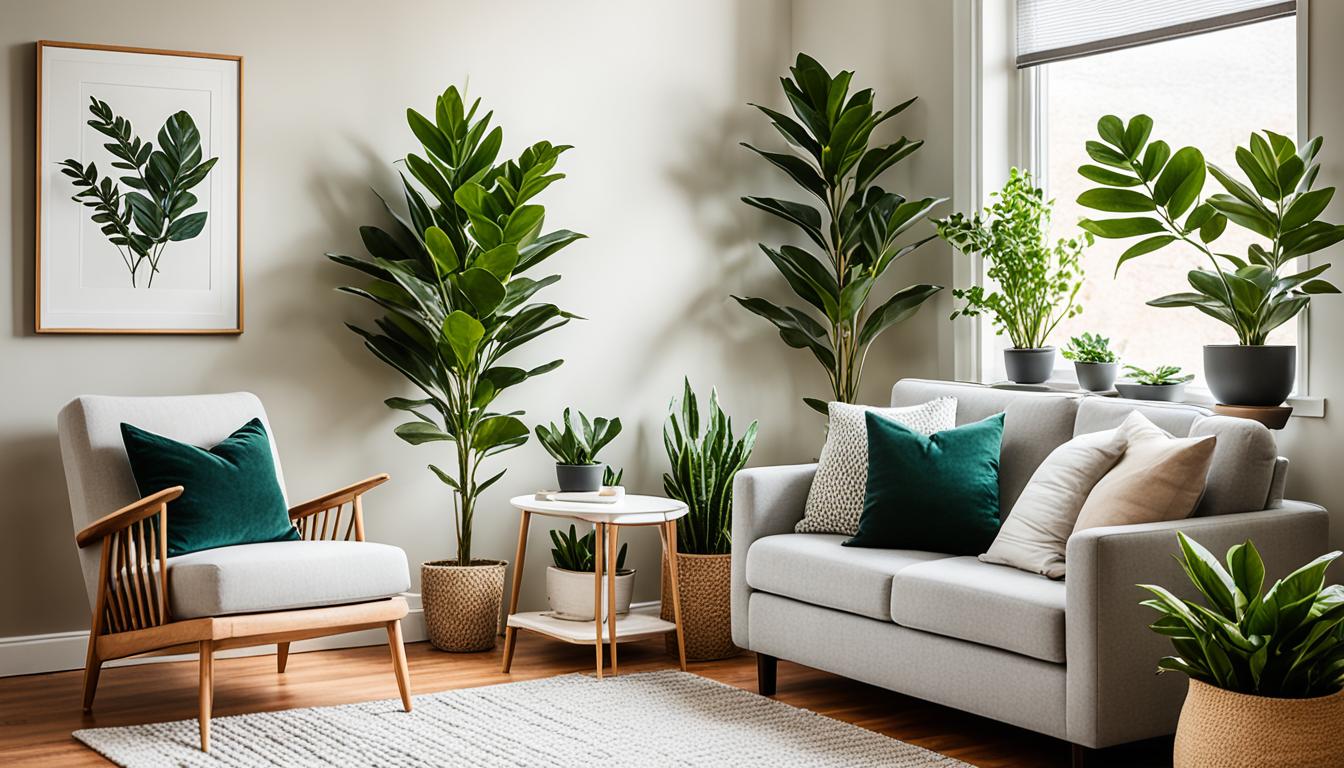The ZZ Plant, or Zamioculcas zamiifolia, is great for apartments. It loves low light and is easy to care for. It also looks beautiful.
In this guide, you’ll learn how to grow and take care of ZZ Plants. I’ll cover choosing pots, soil, light, water, and food. You’ll also learn how to deal with bugs and sickness.
Key Takeaways:
- ZZ Plants are a popular choice for apartments due to their tolerance for low light conditions.
- They are easy to care for and have an attractive appearance.
- The ZZ Plant is air-purifying and pet-friendly, making it a great addition to any indoor space.
- Proper potting, lighting, watering, and nutrition are vital for the ZZ Plant’s growth and health.
- Regular monitoring, pruning, and pest control are necessary for maintaining a thriving ZZ Plant.
Why Do We Love the ZZ Plant For Apartments?
The ZZ Plant is great for apartments because it looks good and helps a lot. It makes your place nicer and is good for apartment living.
Is the ZZ Plant Air-Purifying?
Yes! The ZZ Plant cleans the air. It takes away bad stuff, making your home’s air better. This is great for a healthy place to live.
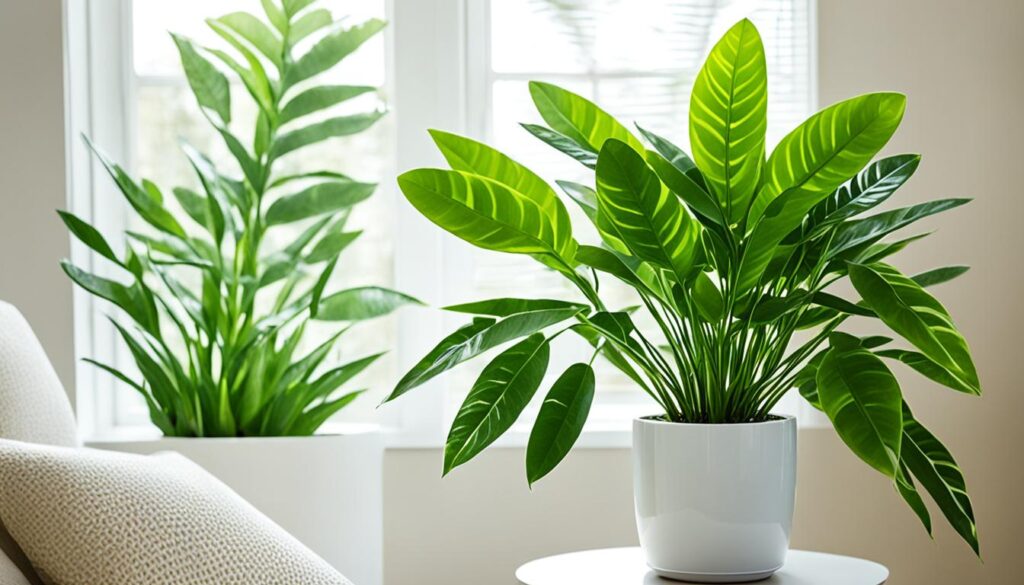
Is the ZZ Plant Pet Friendly?
Yes, it is! If you have pets, don’t worry. The ZZ Plant is safe for cats and dogs. It’s a good plant choice and makes your place pretty.
How Big Does the ZZ Plant Get?
The ZZ Plant can get as tall as 3-4 feet but usually stays small. It’s perfect for small places. It adds beauty without taking up much room.
The ZZ Plant makes your apartment look better and clean the air. It’s also safe for pets. It doesn’t get too big, perfect for small spaces. Now, let’s learn how to take care of this lovely plant.
How to Grow a ZZ Plant – Learn to Grow this Indoor Beauty
Growing a ZZ Plant indoors needs some care. Think about the pot, soil, light, water, and more.
Choosing the Right Pot and Soil
The right pot and soil are important for a ZZ Plant. Pick a pot that lets roots grow and water flow out. Use soil that keeps a bit of water but drains the extra. This keeps the roots happy.
Providing Adequate Light
A ZZ Plant does well in different light settings. But, moderate indirect light is best for its leaves. Don’t put it in direct sun. It can hurt the leaves. Near a window with indirect light is good. Or use grow lights.
Watering and Humidity
Water right and control humidity for your ZZ Plant. Let the soil dry before watering again. This plant doesn’t like too much water. Keep the air around it not too wet or dry. This stops mold from growing.
Nutrition and Fertilization
Fertilizing helps your ZZ Plant grow strong. It doesn’t need much. Use balanced fertilizer and follow the pack. Don’t overdo it. Too much can hurt the roots.
Pruning and Maintenance
Keep your ZZ Plant looking nice with pruning. Cut off bad leaves. Trim long stems for a fuller plant. Clean the leaves to help it breathe and shine.
Propagation
You can make more ZZ Plants. Use stem cuttings or split the plant. Both ways need a piece with roots. Then watch new plants grow.
Monitoring for Pests and Diseases
Watch out for bugs and sickness. Look for pests like mealybugs and spider mites. Keep an eye on leaves and stems. If you see a problem, act fast. This keeps your plant healthy.
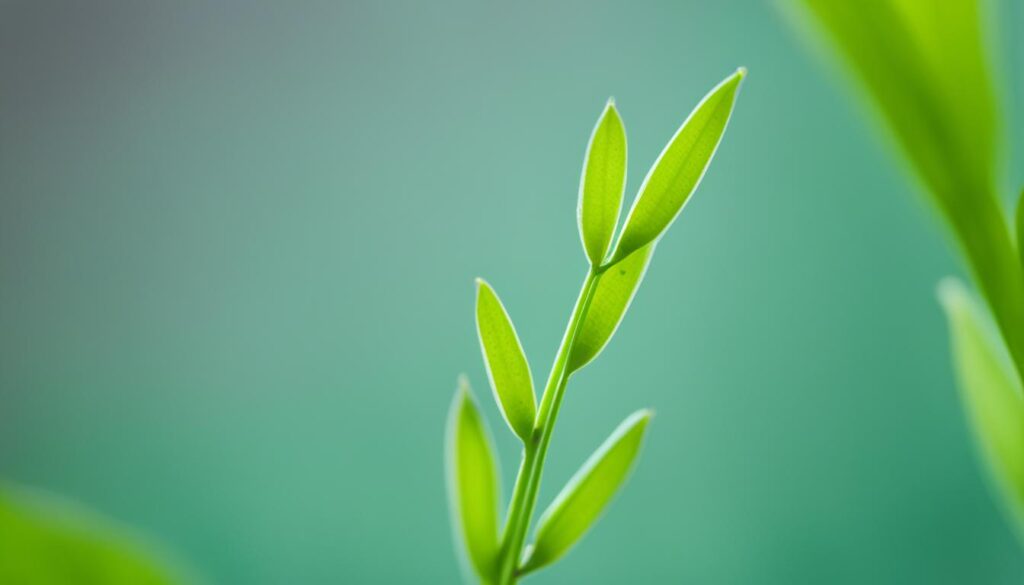
Appearance of ZZ Plant
The ZZ Plant has shiny, dark green leaves. They grow in pairs on long, thick stems. This makes the plant look amazing in any indoor place. The leaves are pinnate, making the plant look like it has feathers.
It grows bushy and tall. This adds a fancy touch to apartments and homes. Look at the image below. It shows how awesome the ZZ Plant looks.
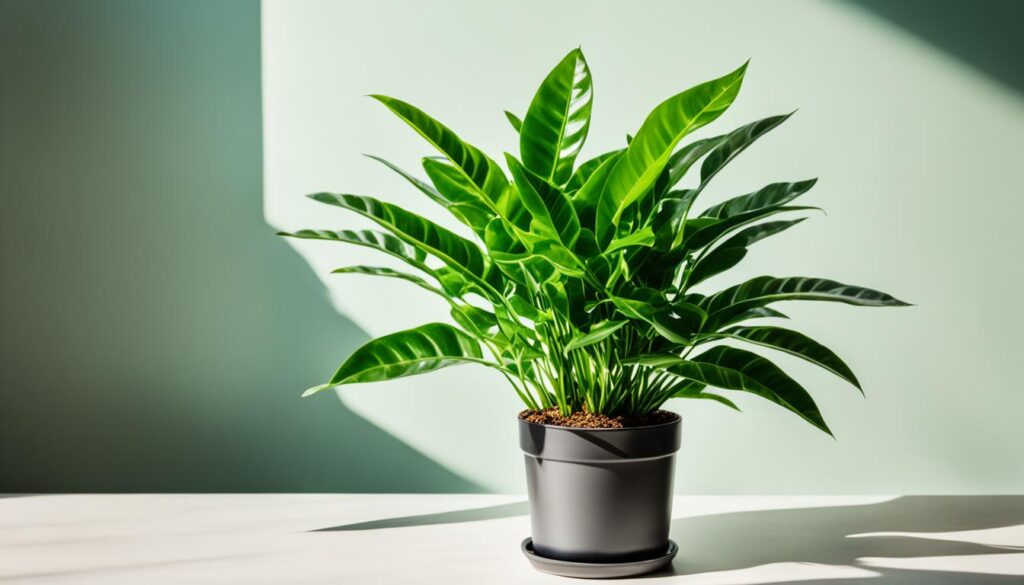
Light Requirements for ZZ Plant
The ZZ Plant, or Zamioculcas zamiifolia, loves shady spots. It’s perfect for dark apartments. Giving it some indirect light makes it grow better and look more lively.
Direct sunlight should be avoided because it burns the leaves. It does best in bright spots without direct sun. A good spot is near a window covered by a sheer curtain.
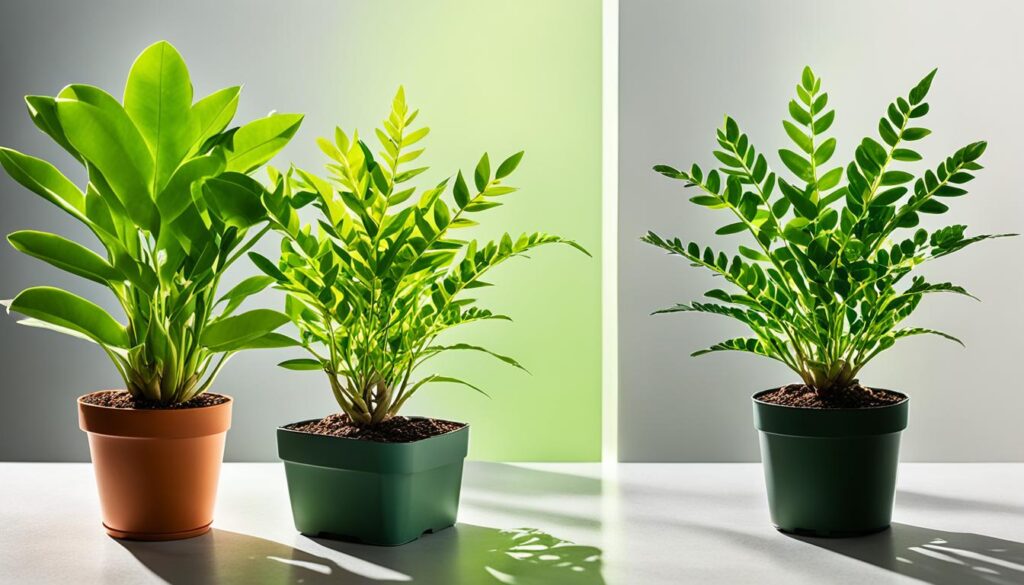
The ZZ Plant likes low light but prefers indirect light to look its best. Finding the right mix of light and shade is key to its happiness and beauty.
| Light Condition | Effect on ZZ Plant |
|---|---|
| Low light (minimal sunlight) | Tolerated, but growth may be slower and foliage may appear less vibrant |
| Moderate indirect light (bright, indirect sunlight) | Promotes healthier growth and more vibrant foliage |
| Direct sunlight | Can scorch the leaves and cause damage |
With the right light, your ZZ Plant will be stunning in your home. Just watch it and change its spot if you need to. This helps it get the light it loves.
Watering Requirements of The ZZ Plant
The ZZ Plant doesn’t need a lot of water to be happy. This makes it great for people who might not remember to water it all the time. Still, knowing how much water to give it is key to keeping it healthy and full of life.
Watering the ZZ Plant just right is what it needs. It does okay if you forget to water it now and then. Or even if you give it a bit too much water sometimes. But it does best with the perfect amount of water.
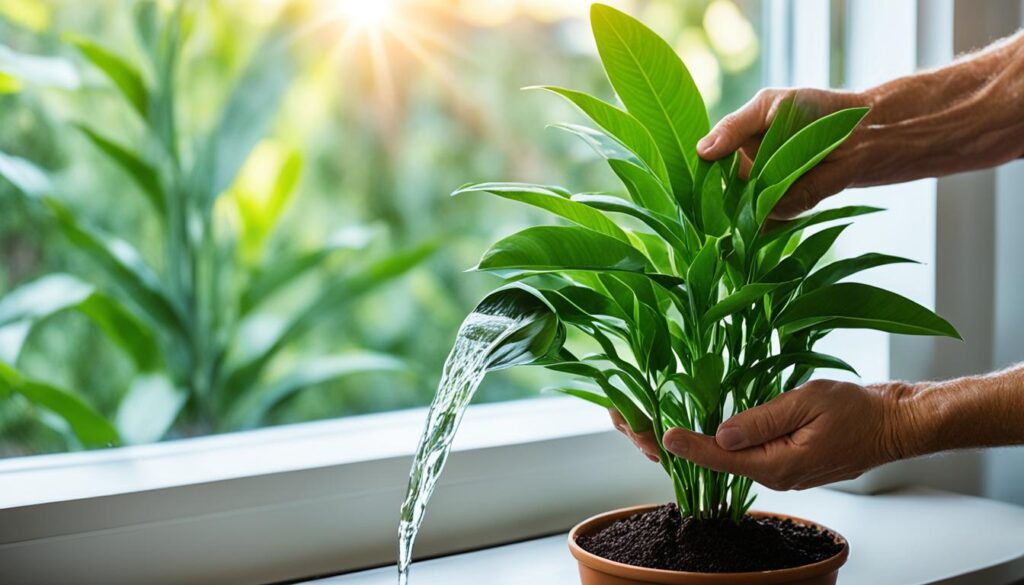
Be sure to let the soil dry before watering your ZZ Plant again. ZZ Plants don’t like their roots to be too wet. This can make them sick. So, wait before you water it again, even if it looks like it needs water.
Signs of Overwatering: Giving your ZZ Plant too much water is bad. Yellow or saggy leaves mean there’s too much water in the soil. Also, if the soil smells bad or the roots are mushy, it’s too wet.
Signs of Underwatering: Not giving enough water isn’t good either. If the leaves droop or look dry, it needs more water.
To find the perfect water amount for your ZZ Plant, watch how it grows. Change when you water it based on what you see. It’s better to give it less water than too much. ZZ Plants can handle being a little dry.
Fertilizing ZZ Plants
ZZ Plants need little fertilizer. They are easy to care for.
But the right food helps them grow and look great.
Recommended Fertilizer for ZZ Plants
Slow-release and water-soluble fertilizers are best. Slow-release ones feed plants over time.
Water-soluble ones work fast and are easy to use.
Use a 10-10-10 or 20-20-20 fertilizer. It should have nitrogen, phosphorus, and potassium. These nutrients help the plant grow well. Additionally, make sure to apply the fertilizer during the growing season for optimal results. Regular feeding will ensure that your plants receive the essential nutrients they need to thrive. For those looking to enhance their knowledge, consider exploring cast iron plant care tips to maintain healthy and vibrant foliage throughout the year.
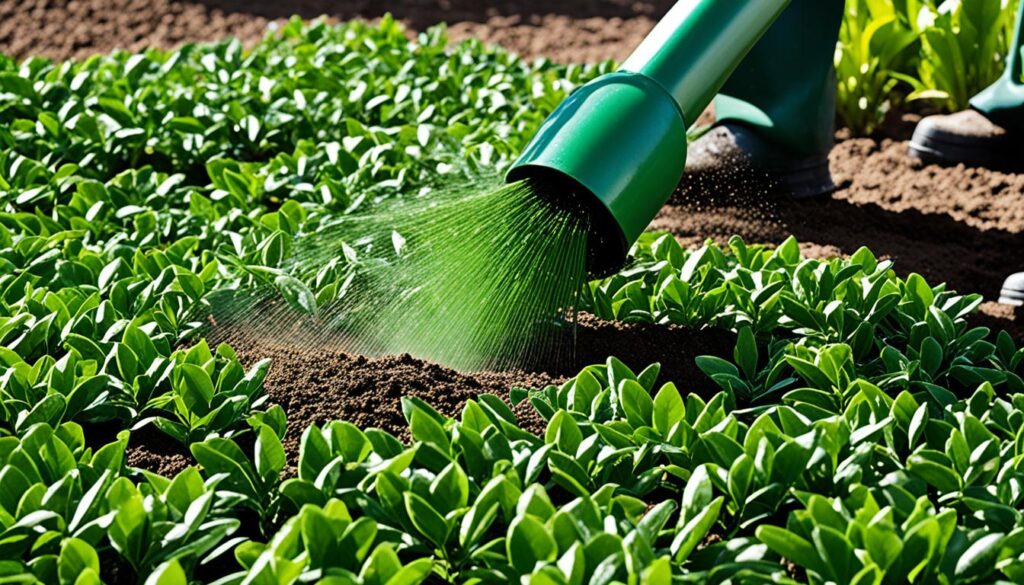
Don’t use too much fertilizer. It can hurt the plant’s roots.
Always check the instructions and use a little at a time.
Flush the soil now and then to avoid salt build-up.
This keeps your ZZ Plants healthy and beautiful.
Potting ZZ Plants
When potting your ZZ Plant, think about pot size, potting mix, and repotting. These are vital for growth and health.
Choosing the Right Pot Size
The pot size matters for your plant’s well-being. It should fit the plant’s roots and how big you want it to get. Too small a pot stops growth. Too big can make roots rot. Pick a pot for healthy roots that fits the plant.
Using the Right Potting Mix for ZZ Plants
The right potting mix is key for good growth. Use a mix that drains yet keeps some moisture. This stops overwatering and lets roots get air. A mix of peat moss, perlite, and a bit of organic matter works well.
Repotting When Necessary
You might need to repot your ZZ Plant every 1-2 years. Do it if it seems root-bound or too big for its pot. Repotting gives the plant more space and fresh nutrients. Choose a new pot that’s a bit bigger with fresh mix.
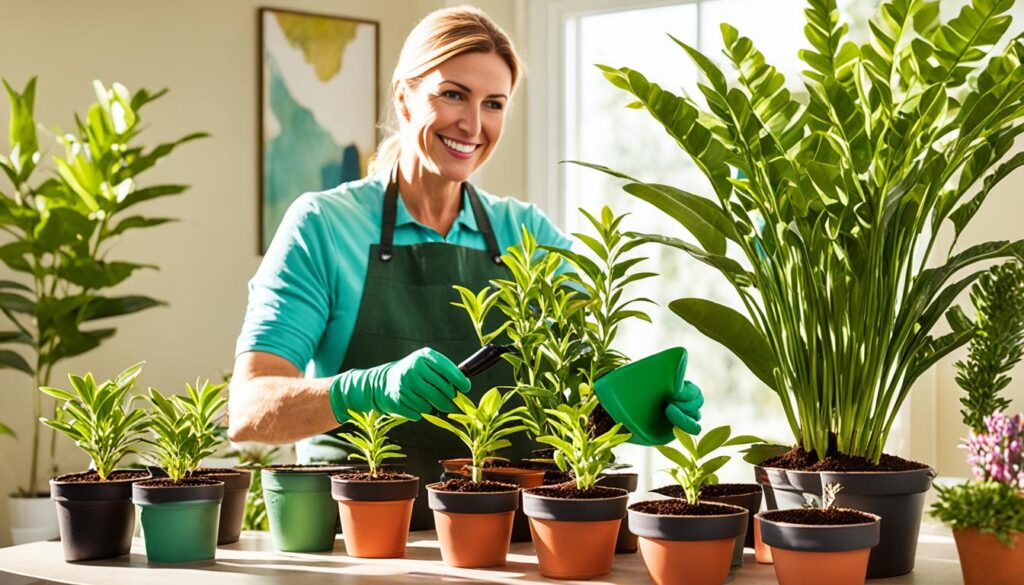
Propagating ZZ Plants
Expanding your ZZ Plant collection is fun. You can also share them with others. There are stem cuttings and division methods.
Stem Cuttings or Seeds?
Stem cuttings are best for ZZ Plants. Take a healthy stem and put it in water or soil. This way is reliable and makes new plants just like the parent.
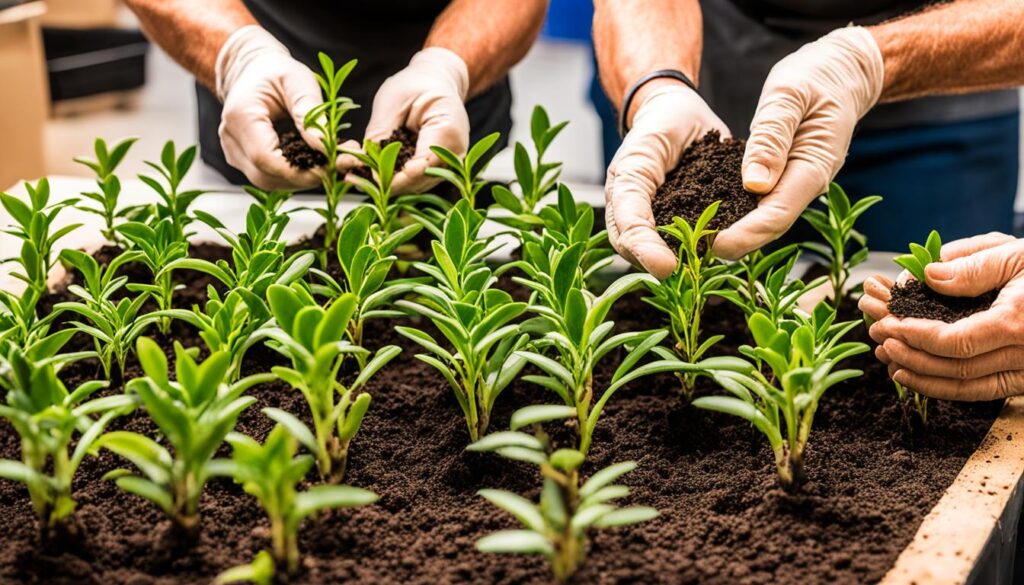
Division of a ZZ Plant
Division is another way to make more ZZ Plants. It’s good for big plants or making many from one. Take the plant out and split it into parts with roots. Then plant them separately.
Seeds aren’t common for ZZ Plants. They hardly make seeds that work. So, people don’t use seeds much.
Growth and Development of ZZ Plants
ZZ Plants grow slow to moderate. This makes them perfect for inside. They can get 3-4 feet high if cared for right. Light, temperature, water, and food affect their growth.
Light is very important for ZZ Plants. They do well in moderate to bright light but not direct sun. Direct sunlight can harm their leaves.
They like to be in temperatures between 60-75°F (15-24°C). Very cold or very hot weather is bad for them.
ZZ Plants can survive without much water. But, don’t water them too much. Let the soil dry before watering again. Too much water can rot their roots. Yellow or wilted leaves mean too much water. Droopy, shriveled leaves mean not enough water.
Feeding ZZ Plants right is crucial. Use a balanced fertilizer every few months. A 10-10-10 or 20-20-20 mix is good for them.
With the right care, ZZ Plants will grow well. They need the right light, warmth, water, and food to do their best.
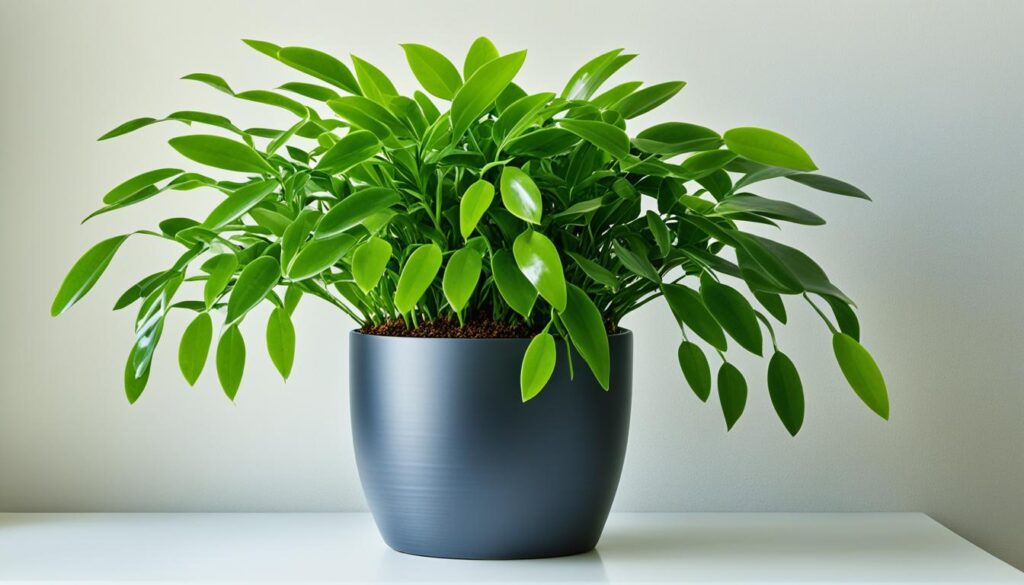
Dealing with Pests and Diseases in ZZ Plants
ZZ Plants are tough but can face pests and diseases. It’s key to act fast to stop more damage.
Common Pests
ZZ Plants might get attacked by pests like:
- Mealybugs
- Spider mites
- Scale insects
These bugs can hurt the leaves and plant’s health. Check the plants often and catch problems early.
Diseases
ZZ Plants can get sick, especially if we don’t care for them right. Root rot and leaf spot are usual sicknesses from too much water or bad air flow.
Root rot happens when roots sit in too much water. Leaf spot shows as dark, wet spots on leaves. Good watering and air around the plant stop these sicknesses.
Treatment
Finding pests and diseases early in ZZ Plants is very important. Here’s how you can treat them:
- Natural Remedies: For small bug problems, use natural fixes. Try neem oil, insect soap, or water plus dish soap. Make sure it hits the sick spots well.
- Isolation: See bugs or sickness? Keep that plant away from others. This stops the spread and makes caring for it easier.
- Chemical Treatments: If natural ways don’t work, you might need chemicals. Ask a plant expert or look up the best chemicals for ZZ Plants.
Using bug killers? Follow what the maker says. And be safe for you and nature.
Common ZZ Plant Pests
ZZ Plants don’t get sick easily, but some bugs can still bother them. If bugs attack, they can harm the plant’s leaves and health. The bugs that like ZZ Plants are:
- Mealybugs
- Spider mites
- Scale insects
Mealybugs look like small, white, fluffy bugs. They hang out on leaves and stems. They drink the plant’s sap. This makes leaves turn yellow and wilt.
Spider mites are really tiny bugs. They make webs on the plant’s leaves. They take the plant’s juices, making leaves yellow and have marks.
Scale insects are tiny, round bugs. They stick to the leaves and stems. They can turn leaves yellow, make them fall off, and stop growth.
It’s smart to check your ZZ Plants often for bugs. Found some? You can take them off with a cotton swab with rubbing alcohol. Or, spray them with soapy water or neem oil.
| Pest | Description | Treatment |
|---|---|---|
| Mealybugs | Small, white, cottony insects that feed on the plant’s sap | Remove manually with alcohol-soaked cotton swab or use insecticidal soap |
| Spider mites | Tiny pests that cause webbing and suck the plant’s fluids | Wipe leaves with a damp cloth, use insecticidal soap or neem oil |
| Scale insects | Small, round pests that attach to leaves and stems | Remove manually with alcohol-soaked cotton swab or use insecticidal soap |
Looking after your ZZ Plants stops bugs. If you see bugs early, you can help your plants. This way, they stay healthy and make your home look nice.
Natural Predators
ZZ Plants stay healthy when pests are kept in check. Ladybugs and predatory mites love eating pests like mealybugs. They help keep your plants happy and healthy.
Isolate Infected Plants
See pests on your ZZ Plants? Act fast to stop them from spreading. Move sick plants away from healthy ones. This keeps other plants safe from pests.
Chemical Treatment
Sometimes, you might need chemicals to fight pests. Be careful and follow directions to keep everyone safe. Use soaps or organic sprays for bad pest problems.
But, try natural ways and isolating plants first. Doing all these can keep your ZZ Plants healthy and pest-free.
Disease Prevention for ZZ Plants
Proper care keeps ZZ Plants healthy. Give them enough light, avoid too much water, and keep air moving.
Light is vital for ZZ Plants. They like indirect sunlight. So, place them near a window but not in direct sun.
Let the soil’s top inch dry before watering again. This stops root rot.
Good air flow is key. It stops moisture build-up and fungus. Make sure plants aren’t too close together.
Use a fan or open windows to help air circulate better.
Check your plants often for signs of illness. Yellow or brown leaves and wilting are warning signs.
Take quick steps if you see problems. Remove bad leaves or change how you water.
Staying alert helps keep ZZ Plants happy. You’ll enjoy their beauty for many years.
Tips for Maintaining ZZ Plants
Keeping your ZZ Plants healthy is very important. Here are tips to keep them looking great:
Wiping Leaves
Wipe the leaves of ZZ Plants with a wet cloth often. It removes dust and helps them photosynthesize well.
Outdoor Exposure
ZZ Plants like being inside but enjoy some time outside too. Put them in shade outside to get light and air. But make sure they don’t get direct sun. It can burn their leaves.
Adjusting Watering Schedule
Change how much you water with the seasons. Water more when they grow and less when they don’t. Check the soil before you water to avoid too much water.
These tips will help your ZZ Plants stay beautiful in your home.
Tips for Successful Overwintering of ZZ Plant
In winter, ZZ Plants need a bit more care. They handle cold but need help to thrive. Here are tips for successful overwintering:
- Find a warm location: Keep your ZZ Plant in a warm spot at home. Make sure it’s away from drafts. Cold air or big temperature changes can hurt the plant.
- Avoid overwatering: ZZ Plants don’t need much water in winter. Too much water can cause problems like root rot. Let the soil dry out a bit before you water again. Always check if the soil is too wet before watering.
To help your ZZ Plant in winter, make sure it’s warm and not too wet. This keeps it healthy and happy.
Growing ZZ Plant from Seed
Growing ZZ Plants from seeds is exciting but rare. It’s harder than other ways to grow them. Getting seeds might be tough.
ZZ Plant Seed Germination
ZZ Plant seeds take time to grow. Be patient:
- Make sure your ZZ Plant seeds are fresh. They look like berry capsules.
- Put them in pots with good soil. Press the seeds in gently.
- Keep the soil moist by misting. Don’t water too much to avoid rot.
- Put the seeds in a warm, bright spot. Keep them out of direct sun.
- Waiting for seeds to sprout takes weeks or months. Keep taking care of them.
- When small leaves appear, move them to new pots. Use good soil again.
- Take care of them like grown ZZ Plants. They need light, water, and food.
Considerations for Growing ZZ Plant from Seed
Remember when growing them from seeds:
- Time and patience: It takes a long time for seeds to grow. You need lots of patience.
- Unpredictable results: The new plants might look different. They can vary in color, size, or how they grow.
Varieties of ZZ Plant
The ZZ Plant, or Zamioculcas zamiifolia, comes in cool types. You can pick from common ZZ Plant, Raven ZZ, ZZ Variegata, and Dwarf ZZ. Each type has its own special look. This makes your indoor plants more interesting.
The common ZZ Plant has shiny dark green leaves. They grow in pairs on big stems. It looks classic and never goes out of style. It’s perfect for any room.
The Raven ZZ is really different. Its leaves are deep purple-black. This makes any room look more elegant and dramatic.
ZZ Variegata is fun too! It has leaves with green and creamy yellow patterns. These make your indoor garden stand out. If you have a small space, the Dwarf ZZ is perfect. It’s small and fits nicely on desks or in tight spots.
You can choose from classic, bold, vibrant, or compact ZZ Plants. There’s a type for everyone’s taste and style. Find the one that you like best.

